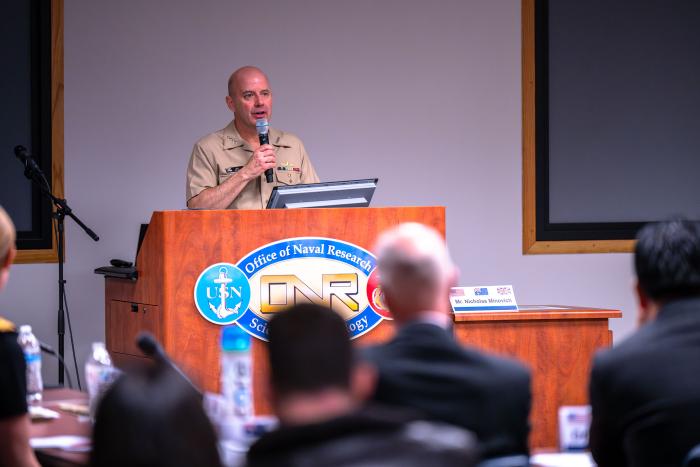On April 3, 2025, the International Engagement Office (IEO) of the Office of Naval Research Global, successfully orchestrated the inaugural Trilateral Naval Capabilities and Science and Technology Talks, bringing together over 100 participants from across the globe. Structured to foster crucial discussions on Science & Technology advancement and joint capabilities, the Trilateral conference featured a series of high-tempo working groups and panels from the United Kingdom, Australia and the United States, focused on increasing warfighting capabilities across the three navies, advancing joint naval strategy and tactics, enhancing operational lethality, and strengthening long-term warfighting advantages. Senior naval leaders from all three nations engaged in substantive discussions on security concerns in the Indo-Pacific region, opportunities to advance defense industrial base collaboration, and strategies to leverage key regional partnerships to deter aggression and increase readiness while maintaining peace and stability.
The Acting Chief of Naval Operations Adm. James Kilby (pictured), who delivered a compelling address to the assembled naval leaders, was joined by other senior naval leaders including Chief of Naval Research Rear Adm. Kurt Rothenhaus; Chief Science and Technology Officer (UK), Dr. Andy Bell; Navy Director Develop (UK) Rear Adm. James Parkin; Head of Navy Capability (AUS) Rear Adm. Stephen Hughes; Director, Integrated Warfare (N9I), Office of the Chief of Naval Operations Rear Adm. Christopher Sweeney; and Chief of Air and Maritime at the Defence Science and Technology Group (AUS) Dr. Ninh Duong.
This trilateral engagement builds upon more than a century of alliance between the United States, Australia and the United Kingdom. The talks represent an extension of the AUKUS partnership established in 2021, which committed the three nations to cooperate on artificial intelligence capabilities, hypersonic weapons, and other advanced technologies. Since the formation of AUKUS, collaborative efforts have expanded significantly, including the Subsea and Seabed Warfare exercise conducted in December 2024. This exercise deployed various unmanned and hybrid undersea systems, demonstrating the practical implementation of AUKUS Pillar 2 initiatives focused on developing advanced capabilities for allied security.
The inaugural talks proved exceptionally productive, establishing a foundation for continued trilateral cooperation. Participants identified several opportunities for joint development projects, technology sharing, and strategic alignment. The engagement reaffirmed collective commitment to revitalizing partnerships and strengthening them to address 21st-century warfighting challenges. As the engagement concluded, working groups were formed to maintain momentum on key initiatives, with follow-up scheduled for later this year. The relationships strengthened during this conference will enhance collective warfighting capabilities and ensure naval forces remain prepared to meet emerging security challenges together.


